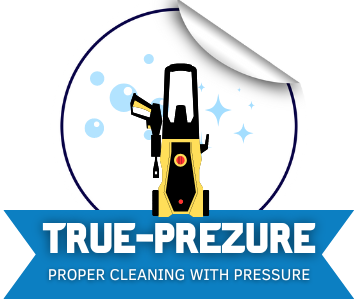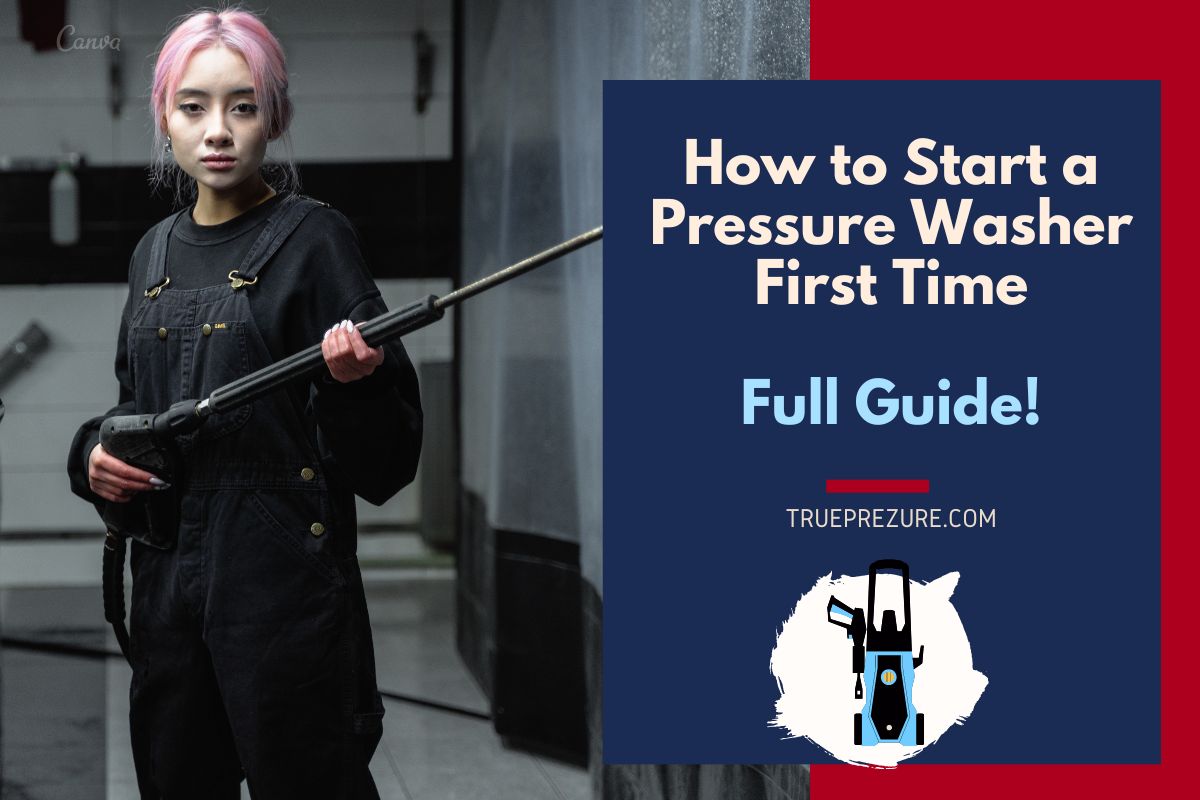Are you excited to finally use your new washer but don’t know how to start a pressure washer first time?
Don’t worry, we’ve got you covered! Starting a pressure washer for the first time can be intimidating, but with our step-by-step guide, you’ll be power washing in no time.
From unboxing and assembling to adding oil and gas and cranking it up, we’ll take you through everything you need to know about starting your pressure washer.
Plus, we’ve included tips on how to safely and effectively use your machine. Let’s get started!
1. Unboxing the Pressure Washer
When you first get hold of your brand-new pressure cleaner, the primary concern is your own welfare.
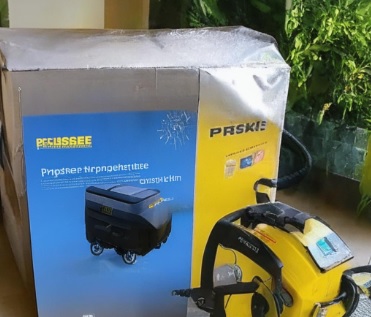
Not only must you put on heavy work gloves and robust glasses or goggles but also seek backup because unexpected accidents happen while cutting tough cardboard boxes. No one likes losing or breaking stuff, either.
For that reason, it’s smart to examine every component individually after you’ve removed them from the packaging. If something appears absent, refer to the owner guide provided and then speak with customer service promptly.
Do these steps efficiently so you spend less time worrying and fix problems before using the power washer. By reading and complying with the guidelines, you reduce the chances of malfunctions or errors, which saves time overall.
Thus, congratulate yourself now since you’re taking excellent action towards maintaining your garden or outdoor features!
2. Assembling the Pressure Washer
Assembling your pressure washer is pretty straightforward once you know what you’re doing. First off, make sure you have all the required components on hand.
Then, follow the instructions provided in the user manual to assemble the various parts of the machine.

Begin by installing the handlebar and wheels. This makes it easier to move the machine around as needed. Afterward, affix any additional equipment that comes bundled with your model, such as quick couplers or tips.
Ensure that all connections are solid and secure before proceeding to lubricate the pump and prime the carburetor by adding fuel and oil as appropriate.
As you begin testing the device, remember to don proper safety gear, including gloves, so you don’t risk oil stains on your hands.
Run a small amount of water into the high-pressure output port with the nozzle attached and test the pressure. Check if all hoses and connections are intact before applying full power to ensure maximum functionality.
If you detect any deficiencies, stop the assembly procedure temporarily to remedy them rather than dealing with more significant concerns further along in the process.
Remember, it’s better to address issues early on than face unnecessary difficulties later. Pressure washing will soon become second nature with practice, so just take your time and enjoy learning the ropes!
3. Adding Oil and Gas to the Pressure Washer
Before starting your pressure washer for the first time, you need to add oil and gas to it. This is an important step that must be done correctly in order for your machine to function properly.
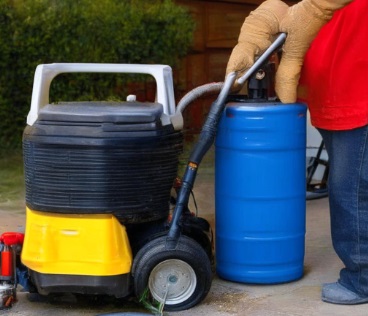
Firstly, check the user manual and find out what type of oil is recommended for your pressure washer. Then, locate the oil fill cap or dipstick on your machine. Remove it and pour in the correct amount of oil. Be careful not to overfill as this can cause damage to the engine.
Next, make sure you have fresh gasoline with a minimum octane rating of 87. Locate the fuel tank on your pressure washer and remove the cap. Pour in enough gas according to how much capacity your machine holds.
Once both oil and gas are added, replace their respective caps securely before starting up your pressure washer.
It’s important to note that using old or contaminated gasoline can harm your machine’s engine over time. Always use fresh fuel when adding gas into your pressure washer.
Do you know What Kind of Oil Does a Pressure Washer Use
Following these steps will ensure that you have properly added all necessary fluids prior to starting up and using your new pressure washer!
Starting the Pressure Washer for the First Time
Starting up your electric pressure washer is simple, but there are a few key steps to follow. Before switching on the power switch, verify the following points:
- Make sure the area where you plan to place your unit is clear from obstacles. Move away any debris or objects that may block airflow.
- Ensure you are wearing eye protection and hearing safeguards since these machines can produce loud noise and flying particles during operation. The manufacturer should provide guidelines on suitable PPE.
- Connect a reliable ground fault circuit interrupter (GFCI) adapter with your extension cord, then plug in the electrical connection between the GFCI and generator. This is a critical element that assists avoid potentially dangerous voltage fluctuations or malfunctions during energy transfer, which could harm people, devices, or buildings.
- Activate your generator, connect the other end of the long cable between the outdoor receptacle, and energize appliances, lights, or security cameras nearby. It’s essential to inspect your community for local regulations regarding portable generators or indoor/outdoor usage before installing. Keep emergency shutoff procedures within reach of anyone who might utilise them in case of unexpected power loss.
- Disconnect your home from external sources. When performing maintenance tasks like cutting grass, pruning plants, filling pools, treating septic tanks, or similar tasks, consult our previous blog posts linked above.
- Lastly, monitor weather patterns continuously, especially wind speed and direction when operating aerial equipment near trees or tall structures to maintain safe distances or minimise risk of accidents. For optimum efficiency, it is advisable to limit extended periods spent working, particularly with prolonged exposure to dust, chemical fumes, or UV radiation, because it increases your susceptibility to potential health hazards due to fatigue. Avoid using machinery during inclement conditions.
Tips for Using the Pressure Washer
Using a pressure washer can be an effective way to clean various surfaces, but it’s important to use it properly. Here are some tips for using the pressure washer:
1. Choose the right nozzle: Different nozzles have different spray patterns and pressures, so choose the one that suits your cleaning needs.
2. Start with low pressure: Always start with a low-pressure setting and gradually increase as needed. High pressure can damage surfaces like wood or paint.
3. Keep a safe distance: Stand at least 6 feet away from the surface you’re cleaning to avoid injury from high-pressure water.
4. Use proper technique: Spray in overlapping strokes, keeping the nozzle moving constantly to prevent streaks or damage.
5. Protect delicate areas: Cover plants or delicate objects nearby with plastic sheeting or tarps before starting any cleaning job.
6. Dress appropriately: Wear protective clothing such as goggles and gloves when using a pressure washer to protect yourself from flying debris and chemicals.
7. Clean up properly: After finishing your work, turn off and unplug the machine and store it safely out of reach of children or pets.
8. Allways use Car Wash Soap In A Pressure Washer
By following these tips, you’ll be able to use your pressure washer effectively without damaging any surfaces or putting yourself at risk of injury!
Pressure Washing Safety
Pressure washing seems straightforward enough—spray down surfaces until they’re squeaky clean.
But before you get started, remember one crucial rule: prioritize safety first. That powerful stream of water might seem harmless coming out of your sprayer, but improper handling can lead to splinters in fingers (ouch), shattered windows, hurt pets, or even knock over unsecured objects.
Don’t say I didn’t warn you! So better put on those googlies and muffle your ears against sudden loud blasts. You know what they say, “no pain, no dirt gain!”
Right? Now scan the ground to ensure nothing will trip you mid-wash. No loose rocks around swimming pool steps, branches overhead, or sticks under patio furniture, correct? Nice job!
Never ever aim your gun directly at people or furry friends! Just imagine how painful it would feel (I bet it wouldn’t tickle). And watch out for electricity—unplug anything close by whenever possible and always use best flexible hose
Also, leave ladders alone since your stable two feet offer more control than teetering three legs. Why tempt fate when a special attachment extends your hose’s reach just fine? Stick to wise choices to steer clear of trouble.
The manufacturer has done their part; now do yours. Read all about proper techniques before making your unit go zoom-zoom.
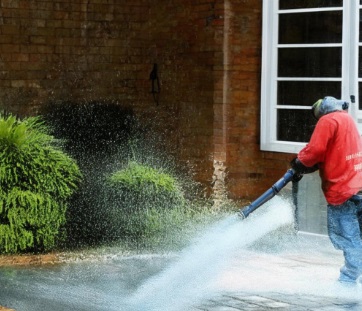
Follow directions strictly, and you’ll have a clean house sans injuries or property damages. See, I told you it pays to play things safe. Happy washing!
keep in mind What Are the Dangers of Pressure Washing the Windows
Conclusion
Starting a new pressure washer needs careful attention. To make sure everything runs smoothly, invest time into understanding the owner’s manual, adding oil & gas, checking hoses, examining valves/regulators, and inspecting attachments.
Take note of warranties, product details, certifications, and features. Finally, practice using different settings for ideal performance. Good luck and happy cleaning!
How do you crank a pressure washer?
The process described requires you to find the choke valve, close it off, open the fuel valve, check all connections, engage the starter cord gently, and keep attempting to start the machine till the motor turns over. Be patient while going through these steps; avoid getting discouraged in case difficulties arise.
Does a pressure washer have to have water running to it to start?
Avoid operating without water or letting it run dry since this increases the risk of permanent damage and injury. For safe startup, always attach a hose, activate the pump, and release nozzle jets for approximately one minute before switching on the device.
What chemicals do you need to start pressure washing?
When it comes to choosing chemicals for your pressure washer, make sure to read the manufacturer’s instructions carefully. Some machines may require specific types of detergents or cleaners, while others may be compatible with a variety of options.
